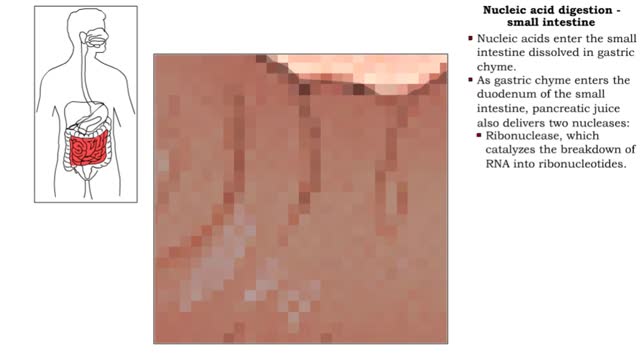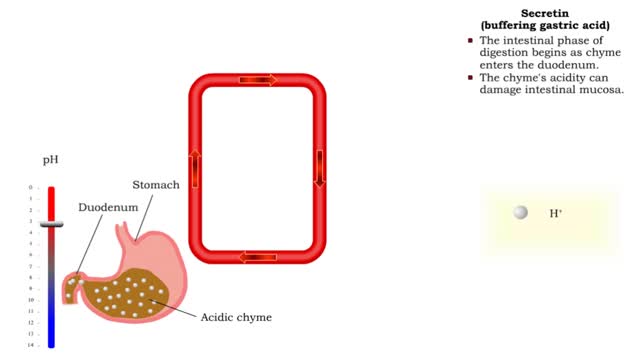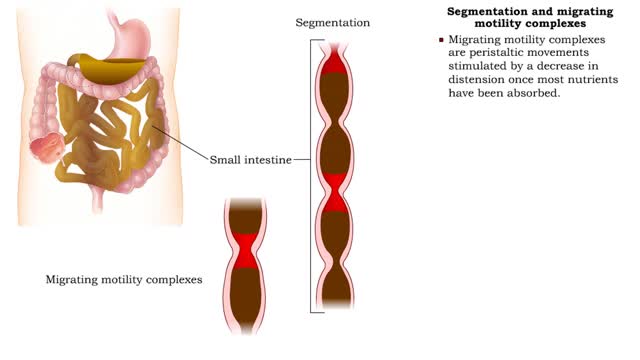Search Results
Results for: 'duodenum'
Lipid digestion - mouth, stomach and small intestine
By: HWC, Views: 11736
ŌĆó Lipid digestion takes place primarily in the small intestine; some occurs in the mouth and stomach. ŌĆó Lipases are enzymes that break down triglycerides and phospholipids. ŌĆó Lingual and gastric lipases hydrolyze a small amount of triglycerides. ŌĆó End products are fatty acids and...
Stomach peristalsis & Enterogastric reflex
By: HWC, Views: 11025
ŌĆó Food enters, distending the stomach. ŌĆó Stretch receptors activate enteric reflexes that promote peristaltic movements. ŌĆó These movements, called mixing waves, begin to mix the food with stomach secretions. ŌĆó Mixing waves force the digesting food (chyme) toward and through the pylo...
Secretin (inhibiting gastric acid secretion), Cholecystokinin (fat digestion) & Cholecystokinin
By: HWC, Views: 11453
ŌĆó As chyme approaches the small intestine, secretin also targets acid-producing parietal cells in the gastric mucosa. ŌĆó Increased secretin inhibits gastric add secretion. ŌĆó With less gastric acid produced, the chyme going into the intestine is less acidic. ŌĆó The hormone CCK also reg...
Nucleic acid digestion -small intestine
By: HWC, Views: 11703
Nucleic acid digestion, which takes place in the small intestine, involves: ŌĆó Pancreatic nucleases. ŌĆó Brush-border enzymes in the small intestine. ŌĆó Nucleic acids enter the small intestine dissolved in gastric chyme. ŌĆó As gastric chyme enters the duodenum of the small intestine, p...
Gastrin (gastric emptying) & Secretin (buffering gastric acid)
By: HWC, Views: 11128
ŌĆó Gastrin also binds to the smooth muscle cells in the stomach causing: ŌĆó Increased gastric motility. ŌĆó Opening of pyloric sphincter. ŌĆó Increased gastric emptying. ŌĆó The intestinal phase of digestion begins as chyme enters the duodenum. ŌĆó The chyme's acidity can damage int...
Segmentation and migrating motility complexes & Gastroileal reflex
By: HWC, Views: 11408
ŌĆó Within a few hours, most of the stomach contents are in the duodenum. ŌĆó Distension of stretch receptors in the small intestine activates a reflex that stimulates segmentation, a mixing movement. ŌĆó During segmentation, sections of the intestine are constricted. ŌĆó This movement incr...
Carbohydrate digestion - mouth and stomach & pancreas and small intestine
By: HWC, Views: 11457
ŌĆó Digestion of complex carbohydrates (starches and glycogen) involves: ŌĆó Amylases produced by the salivary glands and pancreas. ŌĆó Brush-border enzymes in small intestine. ŌĆó In the mouth, amylase from the parotid and submandibular salivary glands begins carbohydrate digestion. ŌĆ...
Protein digestion - stomach & small intestine
By: HWC, Views: 11108
ŌĆó Protein digestion occurs in the stomach and small intestine. ŌĆó The stomach enzyme pepsin initiates the process. ŌĆó Pancreatic and intestinal brush border enzymes complete the digestive process. ŌĆó In the stomach, pepsin is created from pepsinogen in the presence of pH-lowering hyd...
Nucleic acid digestion - brush border enzymes, end products & transport mechanism
By: HWC, Views: 11432
ŌĆó Further digestion occurs at the microvilli (brush border) of the epithelial cells of the villi in the small intestine. ŌĆó Two brush border enzymes complete nucleic acid digestion: ŌĆó Phosphatases, which catalyze the cleavage of a phosphate to form a nucleoside (nitrogenous base and pent...
Advertisement











